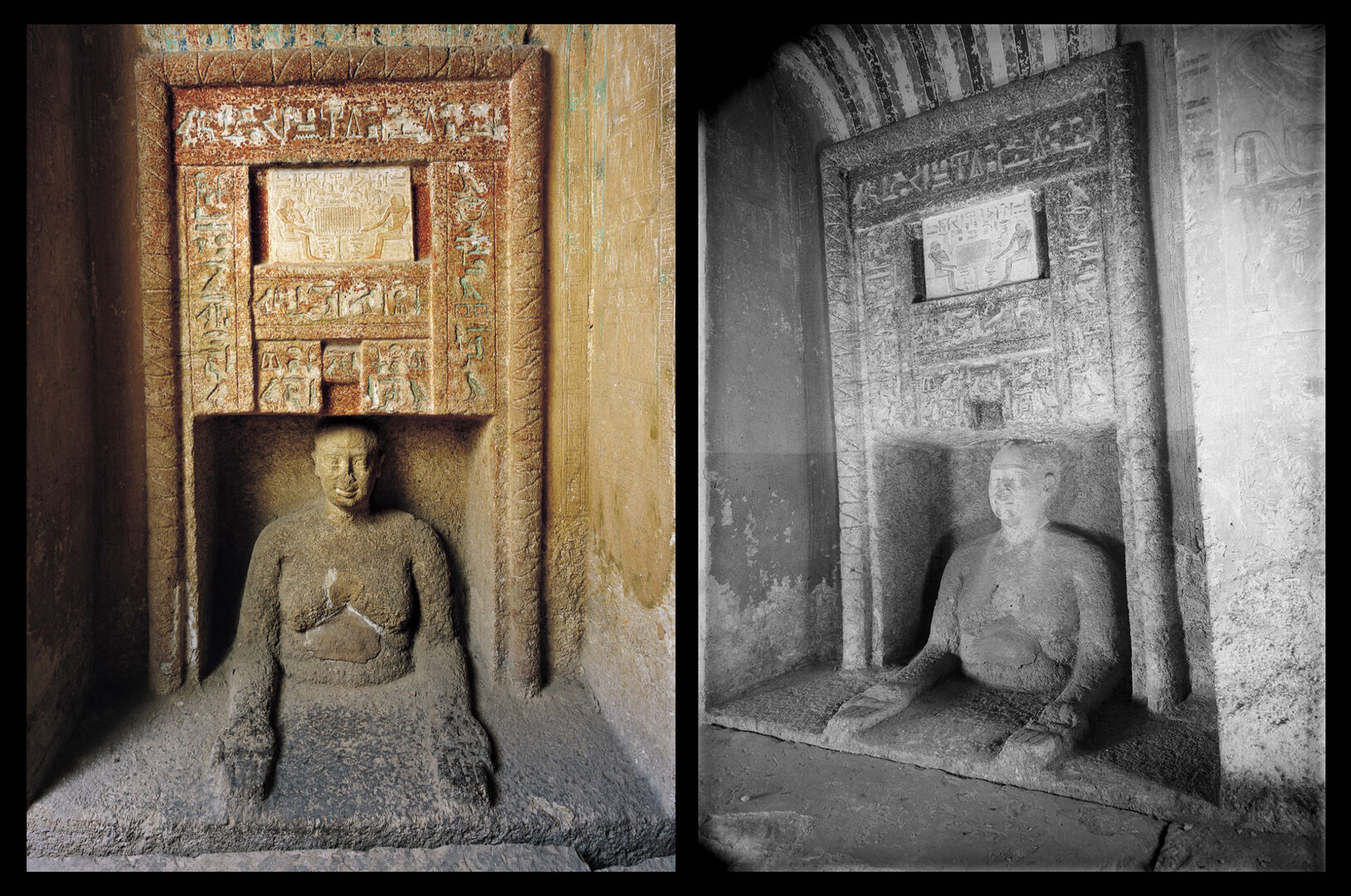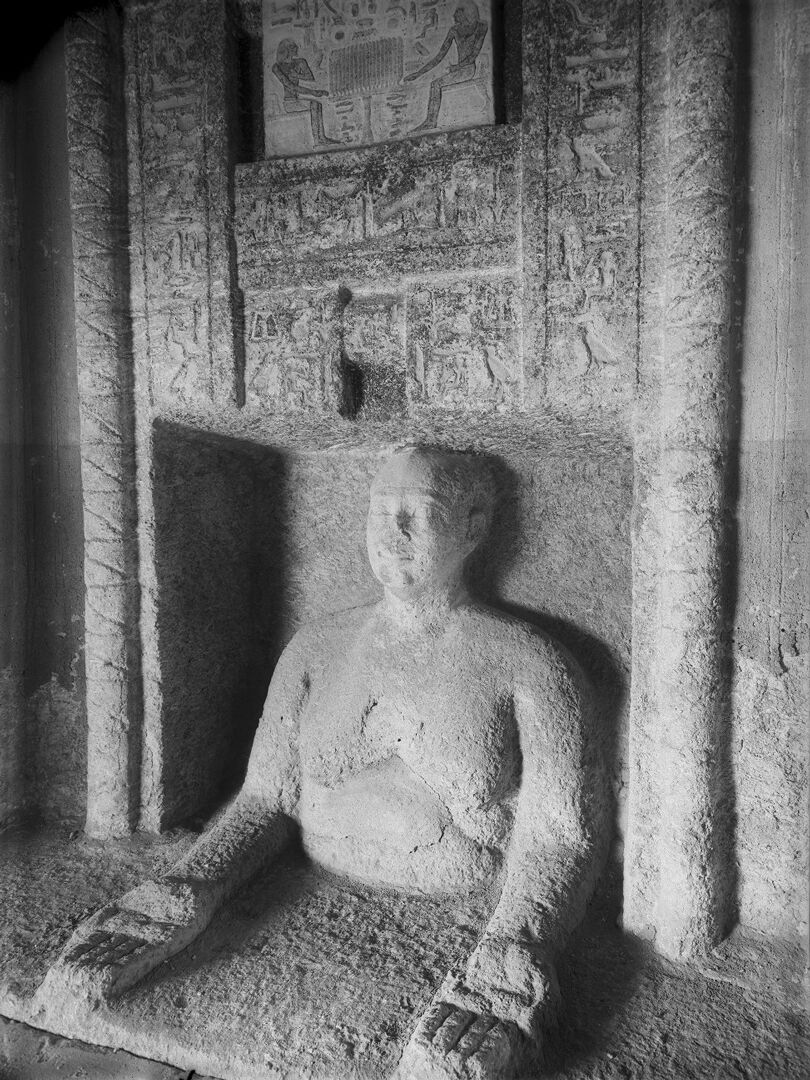The Mastabas of Qar and Idu G 7101 and 7102 - Digitally Revised and Enhanced Edition
Part II - Idu G 7102
Section 3.6 - Offering Chamber - West Wall, Niche
West Wall (Niche) of the Offering Chamber in relation with area north of G7110-7120; Qar(G7101) and Idu (G7102) (click to enlarge)
West Wall, Niche. Orthomosaic by Luke Hollis (left), and Figure 40. Idu (G7102). Stela niche (right) (Click to enlarge)
A large stela painted to imitate red granite under a cavetto cornice, framed in a torus moulding, with below a rock-cut half-length engaged statue of Idu, the hands extended forward, palm up, to receive the offerings on the offering table lying on the floor below.
(1) Horizontal inscription at top reading right to left, within the mouldings: Ḥtp di nswt ḥtp di Inpw pr-ḫrw (t ḥnḳt pꜣt) n imꜣḫw Idw, “an offering which the king gives and an offering which Anubis gives, that an invocation offering (bread, beer, cakes) come forth for the well- provided Idu.”
(2) Tablet in the center, below (1): at either side a seated figure of Idu, each facing in. In the center a table of bread, beneath which, on either side, is inscribed dbḥt ḥtpt “funerary offerings.” Above the table of bread, vertically: pr(t)-ḫrw (t ḥnḳt pꜣt) n: “an invocation offering of (bread, beer, cakes) for.” At the top, flanking the foregoing, two parallel inscriptions, reading out from the center: imꜣḫw sš ꜥ nswt Idw: “the well-provided king’s letter scribe Idu.”
(3) Vertical inscription at right, within the frame of the stela: imy-r wpt ḥtp-nṯr m prwy Idw, “overseer of the distribution of divine offerings in the two houses, Idu.”
(4) Vertical inscription at left of (2) within the frame: sš ꜥ nswt ḫft ḥr imy-r sš mrt Idw, “king’s letter scribe in the presence, overseer of the scribes of the meret-serfs, Idu.”
(5) Horizontal inscription reading right to left below (2) and between (3) and (4). H̱ry tp nswt mdw rḫyt iwn knmwt Idw, “he who is at the head of the king, staff of the rekhyet-people, pillar of Kenmet, Idw.”
(6) Below (5) at right facing left vertical inscription: H̱ry tp nswt Idw, “he who is at the head of the king, Idw.”
(7) Below (5) at left, facing right, vertical incription, same as (6).
(8) In center, below (5): Idw, “Idu.”
At either side of the niche are vertical panels, curved at the top, with jars of the traditional oils (pl. XXX; fig. 40).
On the left seven registers as follows:
(1) sṯy ḥꜣb with a stoppered jug between two cylindrical jars; (2) ḥknw, with two ovoid jars; (3) sfṯ, with a jar between two cylindrical jars; (4) nẖnm, with a single handled jar between two similar jars without handle; (5) twꜣwt, with a jar with bulbous neck and two spouts between stoppered tall ovoid jars; (6) ḥꜣtt nt ꜥš, with ajar between two ovoid tall jars: and (7) ḥꜣtt nt Ṯḥnw, with three jars.
On the right the same set of traditional sacred oils are represented with their containers:
(1) sṯy ḥꜣb, three jars, the one in the center with a longer neck; (2) ḥknw, with a stoppered jar between two slightly taller jars with lug handles; (3) sfṯ, with a stoppered long necked jar between two cylindrical jars tapering to the base; (4) nẖnm, with jars as in the opposite panel; (5) twꜣwt, with a cylindrical tapered jar between two ovoid jars; (6) ḥꜣtt nt ꜥš, with an ovoid cylindrical jar between two ḥs-type jars; and (7) ḥꜣtt nt Ṯḥnw, with a ḥs-type jar between two stoppered jars.
The panels on both sides are placed between borders with 3-stripe spacers.
Photos from the Archive



.jpg)
.jpg)
.jpg)



.jpg)














0 comment(s)
Leave a comment(We'll keep your email address private)